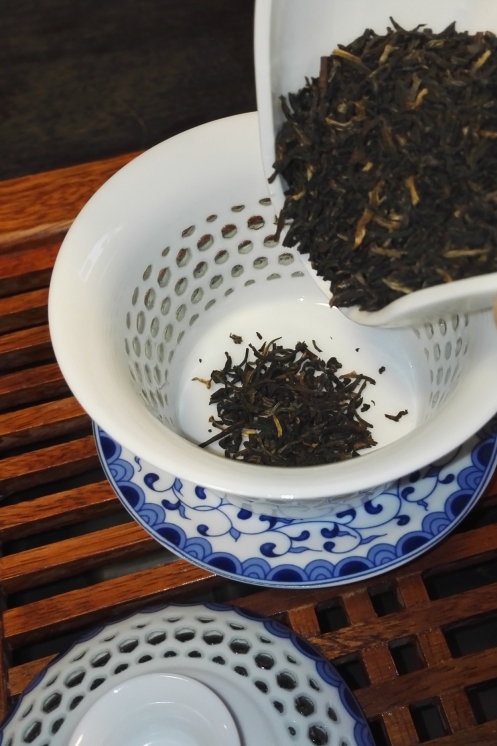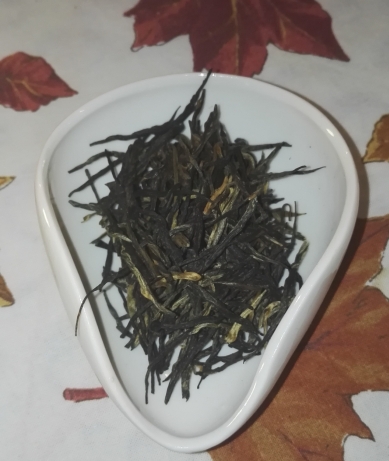This tea is from Mandragora Turku. And it is from a new supplier so you can’t have tasted it before. =) Nor can you find it from the Mandragora web shop. At this moment the tea is in slightly different pouch than the standards they use in Mandragora.
Fast review
Yunnan Black Tea is an organically grown tea from Yunnan province in China. This is a broken grade tea with some buds. No information is given about what leaves have been used to make this tea. Fresh leaves have a sweet and malty odor.
The steeped liquid has a strong body and it is also very sweet. Its astrigency is also very potent. This tea reminds me of cocoa with only little sugar in them. You just need quite a large amount of leaves to make a decent cup.
Leaves can be steeped up to four times. But the first two infusions will have all of the sweetness and “cocoaness”. Later ones are simply astrigent. The taste does not evolve. It simply diminishes.
Pouch and instructions
This tea is packed in a double layered paper pouch which is made of two different types of paper. Inner paper is some kind of butter paper that insulates moisture and air. I dislike these papers since (I think) they tend to give the tea a “papery” dry taste and odor. Oh… and there IS an aluminium foil layer between the papers. So the insulation is quite complete. Unfortunately that does not prevent the tea from acquiring that papery taste if it’s stored in the pouch for longer stretches of time. Please remember to store this tea in a better container. It is worth it!
Instructions are made with pictograms, words and numbers. Given infusion time is from one to two minutes, the temperature is 75-85 celsius degrees and the amount of leaves is from one to two teaspoons. Again you have to presume that the volume of water is one normal cup (1-2 deciliters). Nothing is said about how many times this tea can be steeped. So lets try it out!
Fresh leaves
The odor from the pouch is very sweet and slightly malty. The sweetness is somewhere between brown sugar and maltyness. The sweetness suggests that at least some buds have been used to make this tea. There is no hint of grassiness nor any other fragrances in the dry leaves.
Leaves are uniformly of broken grade. You can find some longer leaves in the mix but those are very rare. Colors in the leaves are dark or even black with a few yellowish brown leaves between them. Finish of the leaves is dull/unshiny.

Steeping
I did my first steeping with 70 degree water for two minutes. The smell of the infusion is heavy with both cocoaness and sweetness. Just like the leaves were.
Two minutes later I get my first taste of this Yunnanic tea.
Even two minute steeping with one spoonful has left the infusion little light to my taste. But the infusion is still robust and sweet. The aroma of cocoa is definitely the strongest element in it and the next one is the honey-like sweetness. The tactile feeling is slightly astrigent even for this slightly under-steeped infusion.
I used both my gaiwan and lid-mug for this tasting/review. On my normal lid-mug I did infusions with one spoonfull and on gaiwan I doubled the amount of leaves and boy did that give A LOT more astrigency to to the infusion. Funnily though the aroma of cocoa did not get any stronger. It actually diminished. Also using hotter water seems to bring out only astrigency.
The second infusion is also fine. The basic structure of the tea stays the same and doesn’t really change in any way. Later infusions just bring out more and more astrigency while the taste is almost totally gone.

Judgement (and alter-steeping)
Teas from Yunnan are one of my favorite tea groups especially in black and smoked categories. And although I did expect more out of this one it really was a lovely tea. The smooth cocoa aroma with the honey sweetness. Tasty! From time to time I find these cocoa tasting teas but this one was the first one to be sweet.
Unfortunately I expected a lot more of this tea. Some lingering feel or developing aroma would have been nice. Still this is a fine tea to have. You can try out different steepings by changing the temperature and time. It can bring out new aromas from the tea.
Final review
Pouch and instructions: 3/5 standard pouch with nice instructions .
Tea – fresh: 4/5 malty and sweet.
Tea – infusion – color n feel: 2/5 warm looking and slightly milky.
Tea – infusion – taste n progression: 3/5 nice taste,no progression.
Bonus: Wonderful cocoa-likeness!
Overall: 3 / 5

